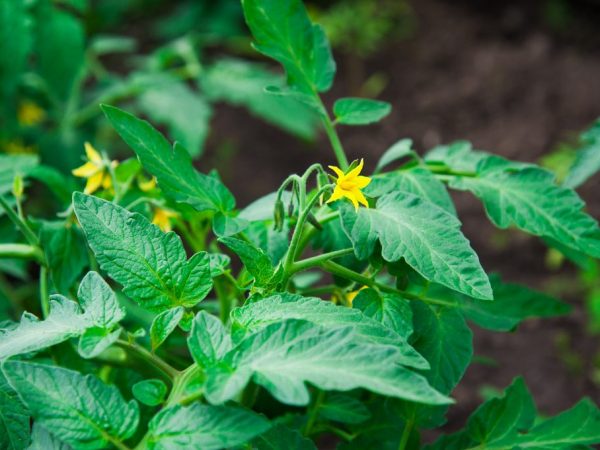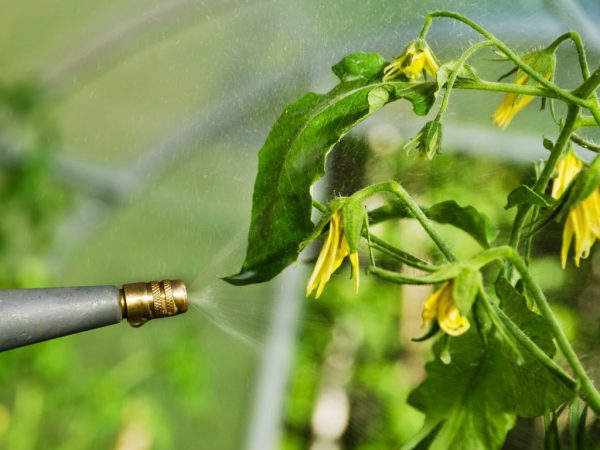Rules for processing tomato seedlings
To speed up the fruiting process, planting seedlings can. But moving tomato seedlings from the greenhouse to open soil is stressful for the plants. Changing the habitat reduces the immunity of plants. Processing tomato seedlings - will make tomatoes resistant to diseases, harden and protect against insect pests.

Rules for processing tomato seedlings
Determining how and what to spray a tomato at the seedling stage can be a problem for a novice vegetable grower.
Diseases of tomato seedlings
Tomato seedlings, even with proper cultivation, are still threatened by different types of diseases:
Fusarium
An infectious disease caused by a fungus.
Infection occurs through seeds. It is a kind of parasite that accumulates in the plant and grows inside its tissues. A clear manifestation occurs when the fruits are poured, the pathogen weakens the plant and wilting begins. Also, infection is possible through the root system - this happens when the soil is not disinfected. Signs of infection are the same as with seed infection - the leaves wilt and the plant dies.
Septoria or white spot
A disease caused by a fungus that is mainly found in open soil, but can affect seedlings in greenhouses or greenhouses. Favorable conditions for the development of the fungus are the high moisture content of the earth.
Septoria most often affects leaves, less often fruits, petioles and sepals. The appearance of small and damp spots, dark in color, speaks of the first signs of the disease. Gradually, they begin to grow over the territory of the leaf, then a gray fungus appears on the spots.
Cladosporium or brown spot
This disease of a fungal nature, if not treated, can destroy up to 50% of the crop.
Fungus development process:
- First of all, young flowers begin to suffer, they are covered with light green spots.
- The disease spreads throughout the bush and infects the leaves.
- The color of the spots changes from light green to yellow-brown.
- At the last stage, the tissues dry out and curl, the death of the bush comes, and the infection passes to another plant.
Black spot
The appearance of black oblong spots on tomato leaves is the first sign of black spot. The disease begins to spread rapidly throughout the plant. Infection occurs through sowing low-quality seeds on untreated soil. High humidity is also a potential causative agent.
Late blight

Signs of the disease will help you choose a solution for processing
It is a very tenacious fungus that can be found in air, soil, and even water. First of all, the leaves are covered with dark brown spots, which then spread throughout the tomato. If you do not process it on time, you can lose the entire crop.
Black skin
Favorable conditions for the development of the fungus are the high density of the planted tomato seedlings. Due to lack of light, the stem begins to dry and turn black, then the tomato breaks and falls.
Mosaic
It is a virus that can destroy all your green spaces. A large number of vectors increase the possibility of tomato infestation. Sources of infection:
- raw tools;
- uncleaned plant residues;
- not disinfected soil;
- large colonies of insect vectors.
First of all, light green or dark speckles appear on the leaves. Then they change the leaf, growths begin to form. In the last stage, the foliage wilts and curls.
Aspermia
A virus that is carried by insects. The disease can be on the host plant, such as a chrysanthemum. The first signs are tomato clarification. Then the upper part begins to curl, the stems develop poorly, the leaves become small, deformed and twisted.
Stick
a viral disease that may outwardly look like late blight. When damaged, the leaves begin to dry and become covered with bloom.
Fight disease
Fusarium
Seed treatment, crop rotation and disinfection of tools are required. You can also pick up a resistant hybrid that can withstand the fungus of Fusarium. If the seedlings are still sick, then watering with a solution from Glyokladin is done. You can also use Planriz, Trichocin, Pseudobacterin, Alirin and Gamair - these are bacterial-based drugs. Of course, you can use chemicals, but you need to remember that after spraying them, you cannot eat the fruits for 2-3 weeks.
Sepatoriosis
Many tomato hybrids are resistant to it, but for reliability it is recommended to remove plant residues from the plot or greenhouse. When the first signs of the disease appear, they are sprayed with fungicides, it is advised to re-spray after two weeks.
Cladosporium
Cladosporium is a fungus, and the best prevention of fungal disease is to monitor the humidity of the air and control watering.
It is also necessary to give the seedlings enough space, not to make dense plantings. Treatment with biological agents or copper chloride will provide the plant with protection. The affected plant can be treated with milk. It is necessary to take 0.5 milk and add 12-15 drops of iodine, then pour water in a ratio of 1:10.
When a tomato is ill with late blight, it is recommended to spray it with folk remedies - these are infusions of ash, tinder fungus, garlic, kefir, salt and milk. It can also be processed with epin.
Prophylaxis
Disease or damage to plants can be avoided by disinfecting the soil before planting or treating the seeds. To avoid many viruses and fungi, it is recommended to do seed treatment before planting. This is done with hydrogen peroxide; it can replace potassium permanganate. The recipe is as follows, it is necessary to put seeds in a 10% solution for 20 minutes. The solution can also be used as a growth stimulant. It is also necessary to monitor the humidity of the air and organize competent watering.
Treatment with drugs
You can carry out a number of treatments using drugs:
- Barrier;
- Fiosporin;
- Alirin;
- Gamair;
- Baxis;
- Barrier;
- Exosil.
It is recommended to use folk remedies like trichopolum, milk whey, infusion of rotten hay or straw, yeast. But remember that before you use something, you need to read the instructions.
Conclusion
Many diseases can be avoided if preventive measures are taken. Maintain the crop rotation and do moderate watering with water, process the seeds before planting.
Experienced growers recommend choosing sustainable hybrids that will not only protect your tomatoes, but also bring a rich harvest.


